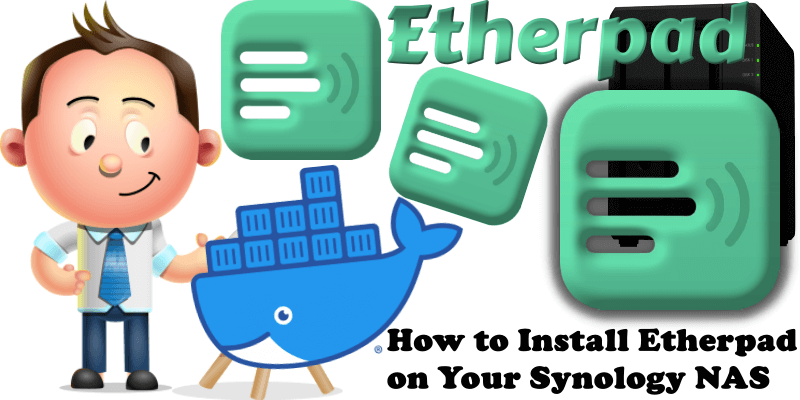
Etherpad is a real-time collaborative editor scalable to thousands of simultaneous real time users. It provides full data export capabilities, and runs on your server, under your control. In this step by step guide I will show you how to install Etherpad on your Synology NAS with Docker & Portainer.
STEP 1
Please Support My work by Making a Donation.
STEP 2
Install Portainer using my step by step guide. If you already have Portainer installed on your Synology NAS, skip this STEP. Attention: Make sure you have installed the latest Portainer version.
STEP 3
Make sure you have a synology.me Wildcard Certificate. Follow my guide to get a Wildcard Certificate. If you already have a synology.me Wildcard certificate, skip this STEP.
STEP 4
Go to Control Panel / Login Portal / Advanced Tab / click Reverse Proxy. Follow the instructions in the image below.
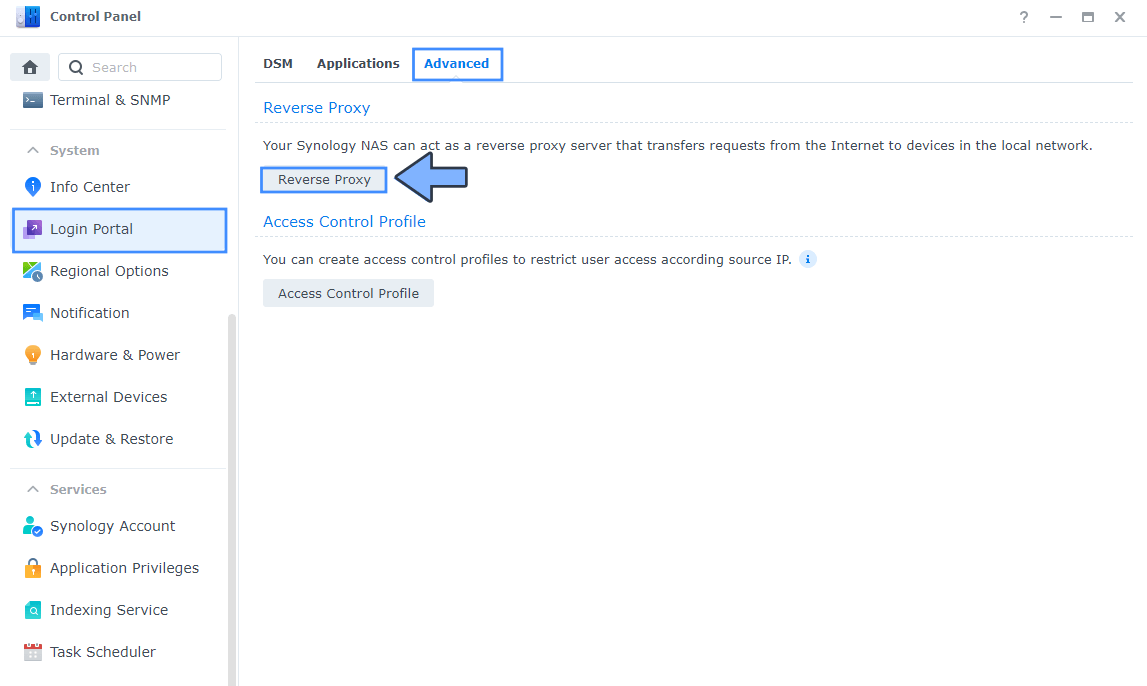
STEP 5
Now click the “Create” button. Follow the instructions in the image below.
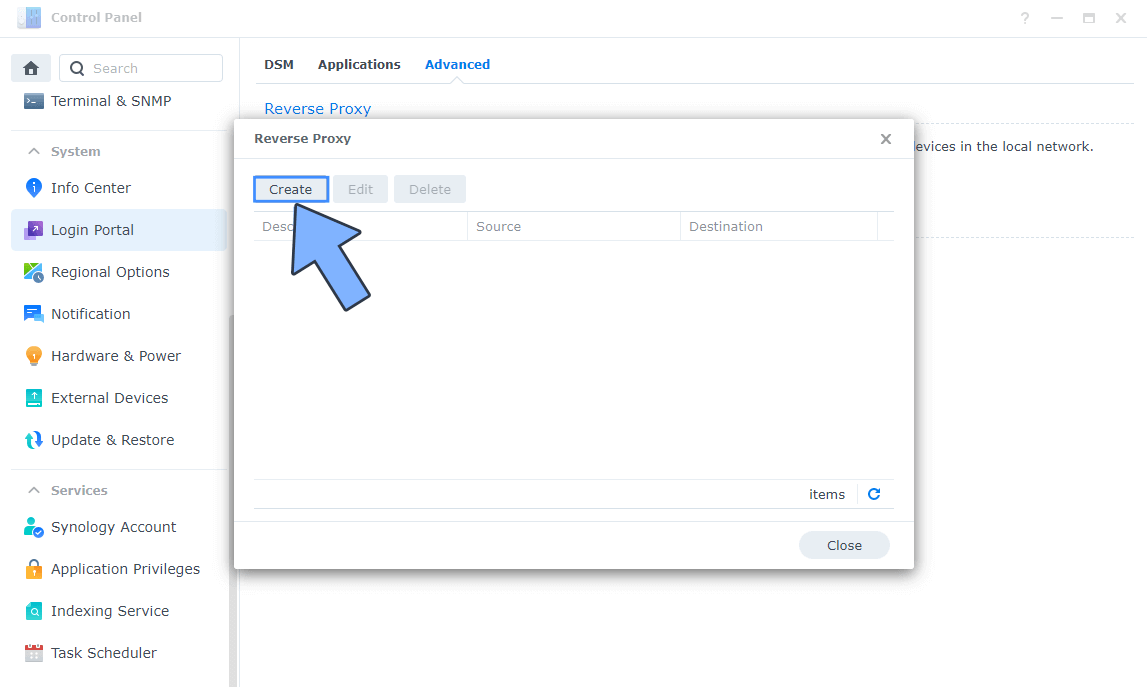
STEP 6
After you click the Create button, the window below will open. Follow the instructions in the image below.
On the General area, set the Reverse Proxy Name description: type in Etherpad. After that, add the following instructions:
Source:
Protocol: HTTPS
Hostname: etherpad.yourname.synology.me
Port: 443
Check Enable HSTS
Destination:
Protocol: HTTPS
Hostname: localhost
Port: 9401
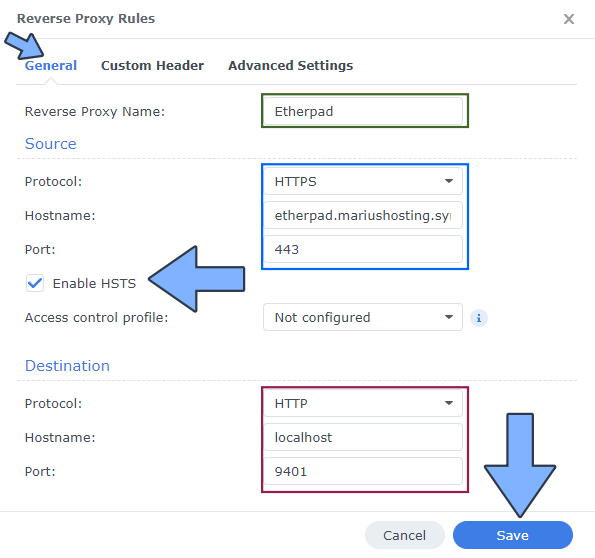
STEP 7
On the Reverse Proxy Rules click the Custom Header tab. Click Create and then, from the drop-down menu, click WebSocket. After you click on WebSocket, two Header Names and two Values will be automatically added. Click Save. Follow the instructions in the image below.

STEP 8
Go to Control Panel / Network / Connectivity tab/ Check Enable HTTP/2 then click Apply. Follow the instructions in the image below.
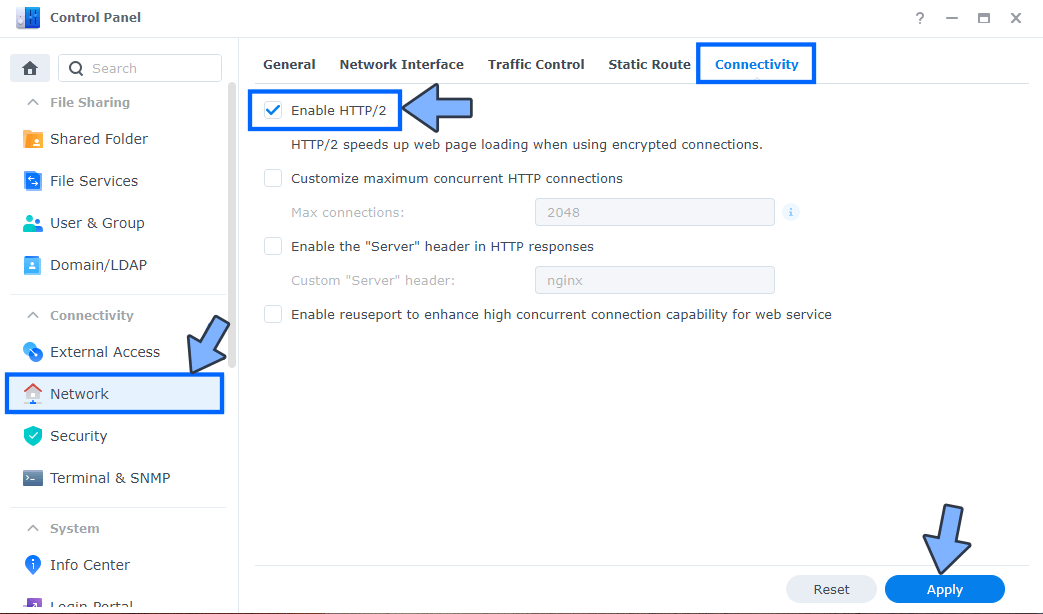
STEP 9
Go to Control Panel / Security / Advanced tab/ Check Enable HTTP Compression then click Apply. Follow the instructions in the image below.
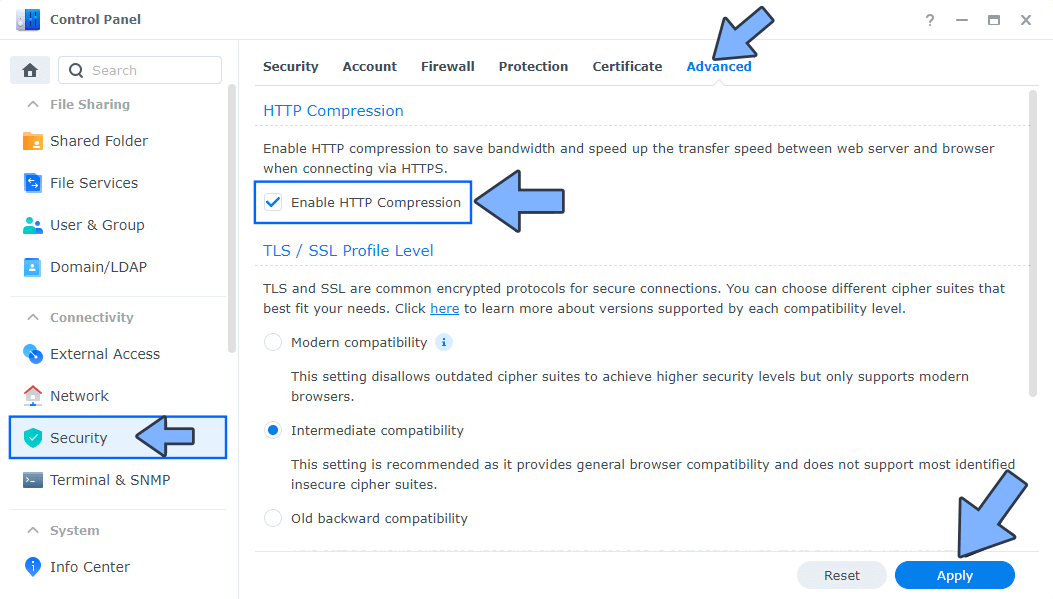
STEP 10
Go to File Station and open the docker folder. Inside the docker folder, create one new folder and name it etherpad. Follow the instructions in the image below.
Note: Be careful to enter only lowercase, not uppercase letters.

STEP 11
Now create two new folders inside the etherpad folder that you created at STEP 10 and name them data and db. Follow the instructions in the image below.
Note: Be careful to enter only lowercase, not uppercase letters.
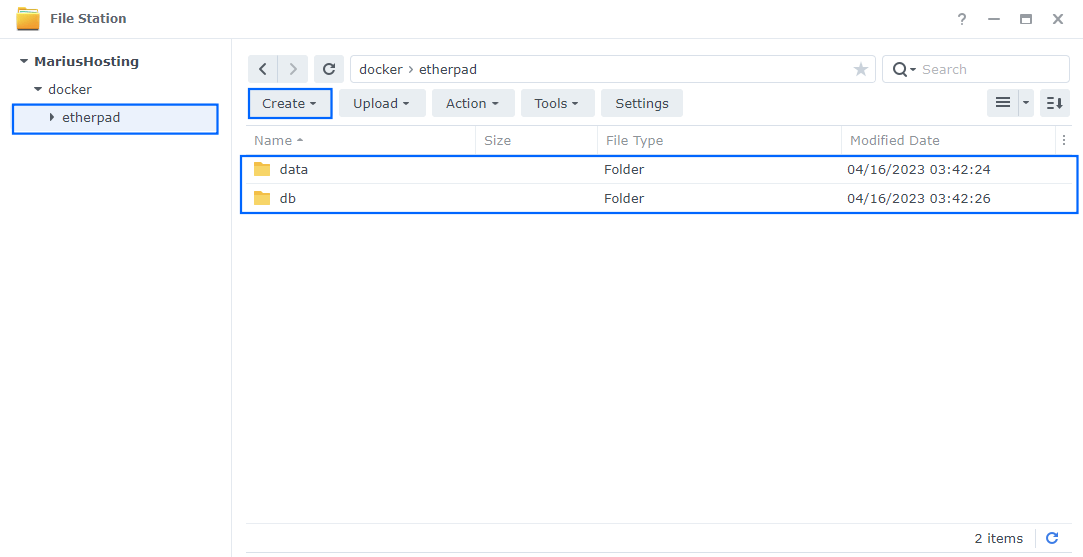
STEP 12
Right click on the etherpad folder that you have previously created at STEP 10 then click Properties. Follow the instructions in the image below.

STEP 13
Go to the Permission tab then click Advanced options. From the drop-down menu choose “Make inherited permissions explicit“. Follow the instructions in the image below.
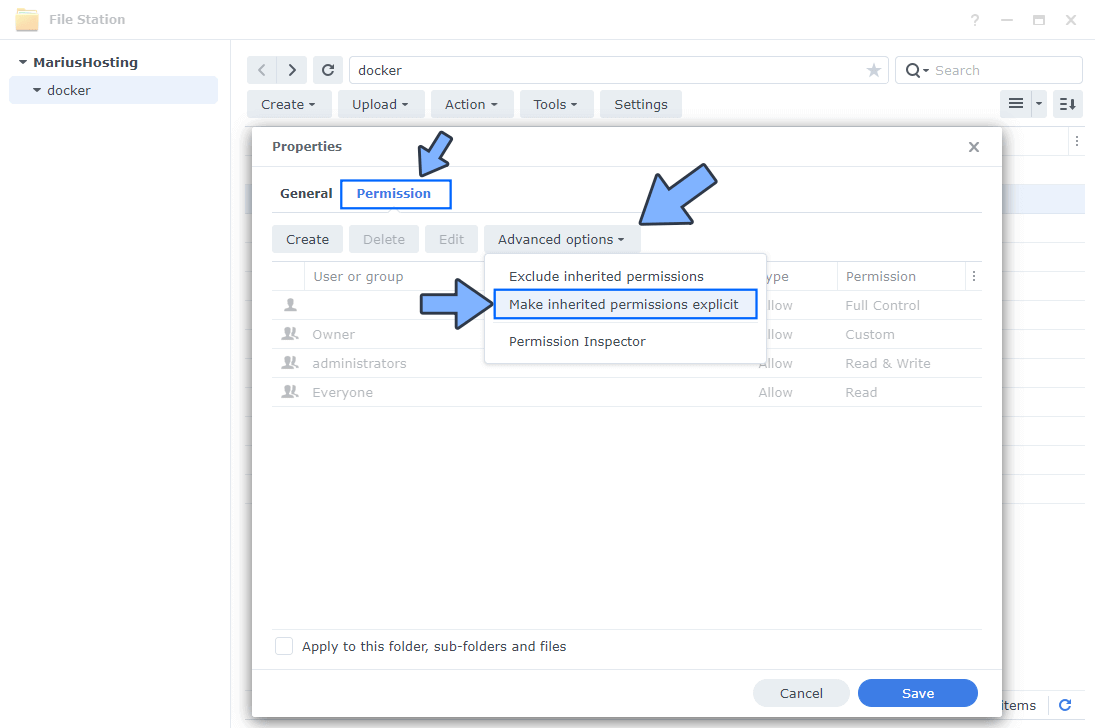
STEP 14
Select Everyone then click the Edit tab. Follow the instructions in the image below.
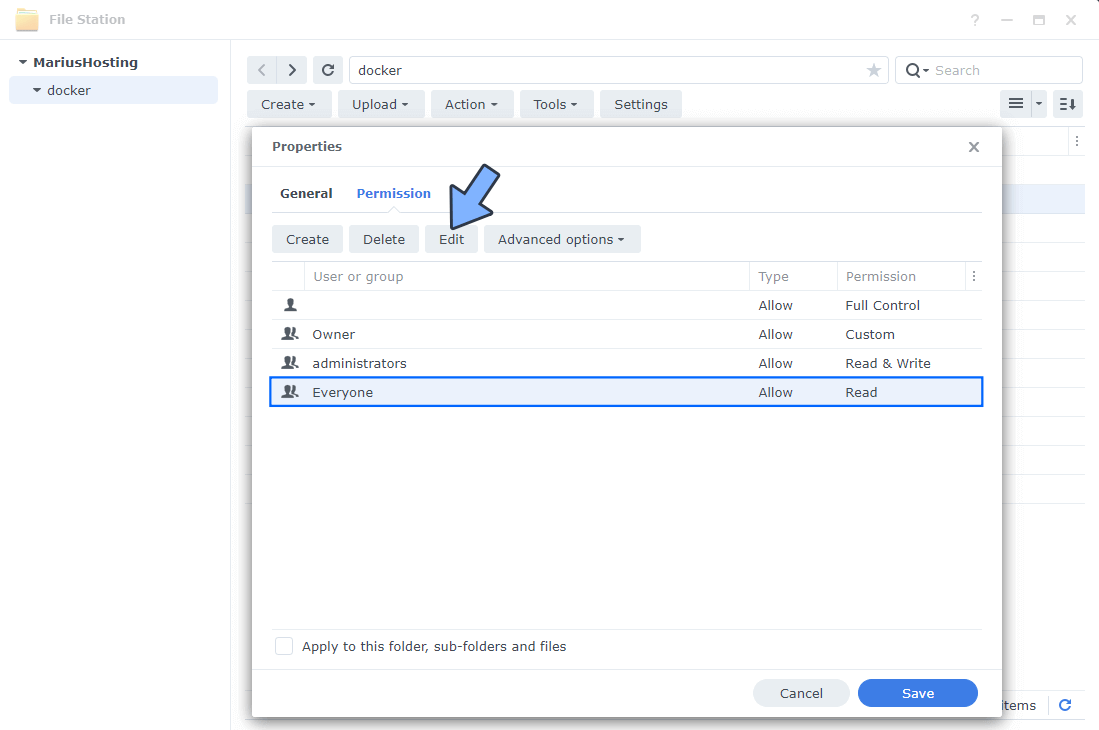
STEP 15
Check all Read and Write Permissions. Click Done. Follow the instructions in the image below.
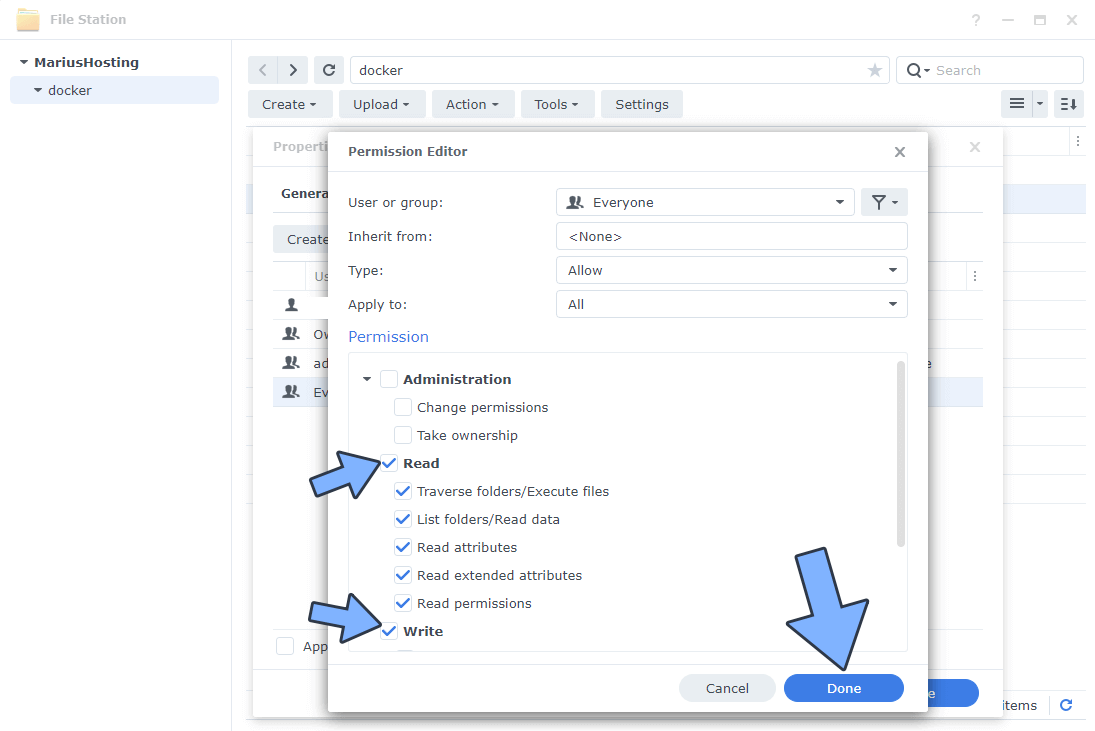
STEP 16
After you click Done on STEP 15, check “Apply to this folder, sub-folders and files“. Click Save. Follow the instructions in the image below.
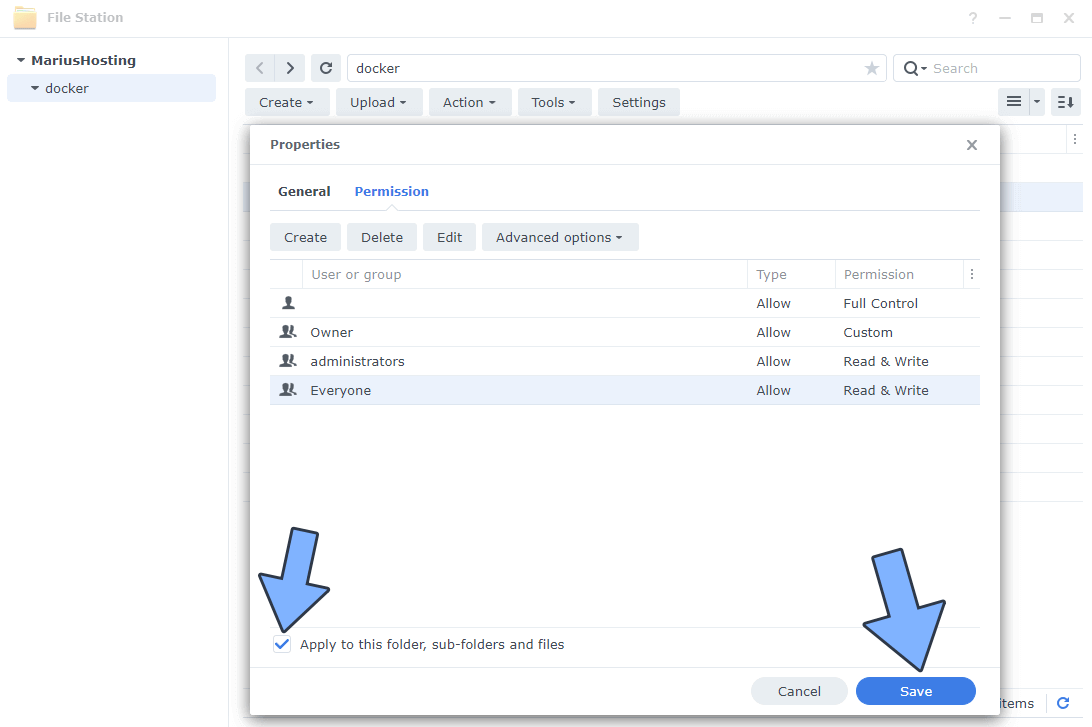
STEP 17
Log into Portainer using your username and password. On the left sidebar in Portainer, click on Stacks then + Add stack. Follow the instructions in the image below.

STEP 18
In the Name field type in etherpad. Follow the instructions in the image below.
services:
db:
image: postgres:16
container_name: Etherpad-DB
hostname: etherpad-db
security_opt:
- no-new-privileges:true
healthcheck:
test: ["CMD", "pg_isready", "-q", "-d", "etherpad", "-U", "etherpaduser"]
timeout: 45s
interval: 10s
retries: 10
volumes:
- /volume1/docker/etherpad/db:/var/lib/postgresql/data:rw
environment:
POSTGRES_DB: etherpad
POSTGRES_USER: etherpaduser
POSTGRES_PASSWORD: etherpadpass
restart: on-failure:5
etherpad:
image: etherpad/etherpad:latest
container_name: Etherpad
hostname: etherpad
mem_limit: 1g
cpu_shares: 768
security_opt:
- no-new-privileges:true
healthcheck:
test: curl -u user:testpassword -f http://localhost:9001/ || exit 1
ports:
- 9401:9001
volumes:
- /volume1/docker/etherpad/data:/opt/etherpad-lite/var:rw
environment:
USER_PASSWORD: testpassword
DB_TYPE: postgres
DB_HOST: etherpad-db
DB_PORT: 5432
DB_NAME: etherpad
DB_USER: etherpaduser
DB_PASS: etherpadpass
IMPORT_MAX_FILE_SIZE: 419430400 # 400MB
TRUST_PROXY: true # If you can't deploy the stack change true to 1
SUPPRESS_ERRORS_IN_PAD_TEXT: true # If you can't deploy the stack change true to 1
REQUIRE_AUTHENTICATION: true # If you can't deploy the stack change true to 1
ADMIN_PASSWORD: mariushosting
restart: on-failure:5
depends_on:
db:
condition: service_healthy
Note: Before you paste the code above in the Web editor area below, change the value for USER_PASSWORD and type in a password for your users. testpassword is an example for a user password. This USER_PASSWORD should be the same as the password in the healthcheck after user:
Note: Before you paste the code above in the Web editor area below, change the value for ADMIN_PASSWORD and type in your admin password. mariushosting is an example for an admin password.
⚠️Warning: If you get an error and you can’t deploy the stack, change the following values TRUST_PROXY: true with TRUST_PROXY: 1 and SUPPRESS_ERRORS_IN_PAD_TEXT: true with SUPPRESS_ERRORS_IN_PAD_TEXT: 1 and REQUIRE_AUTHENTICATION: true with REQUIRE_AUTHENTICATION: 1
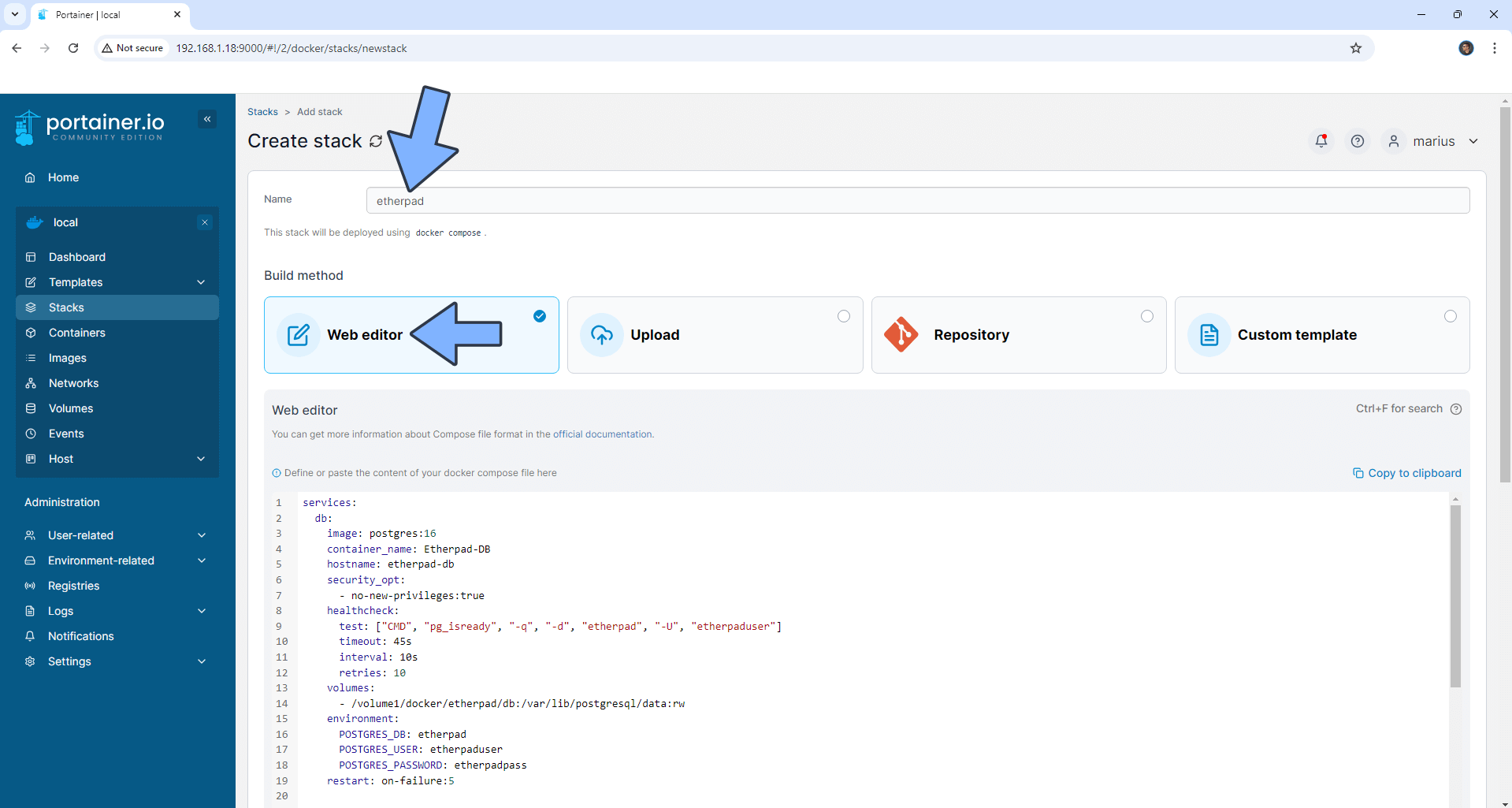
STEP 19
Scroll down on the page until you see a button named Deploy the stack. Click on it. Follow the instructions in the image below. The installation process can take up to a few minutes. It will depend on your Internet speed connection.
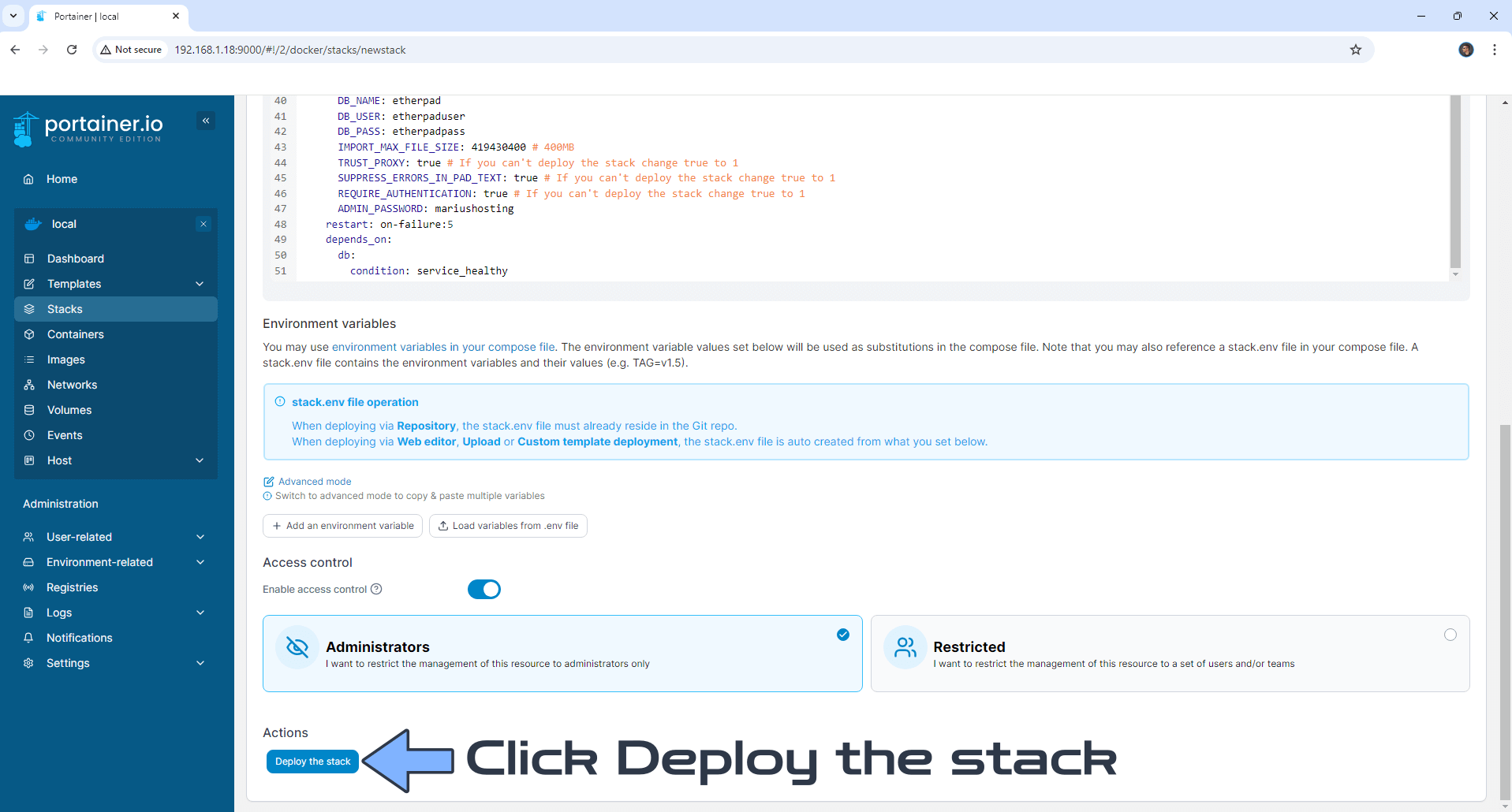
STEP 20
If everything goes right, you will see the following message at the top right of your screen: “Success Stack successfully deployed“.
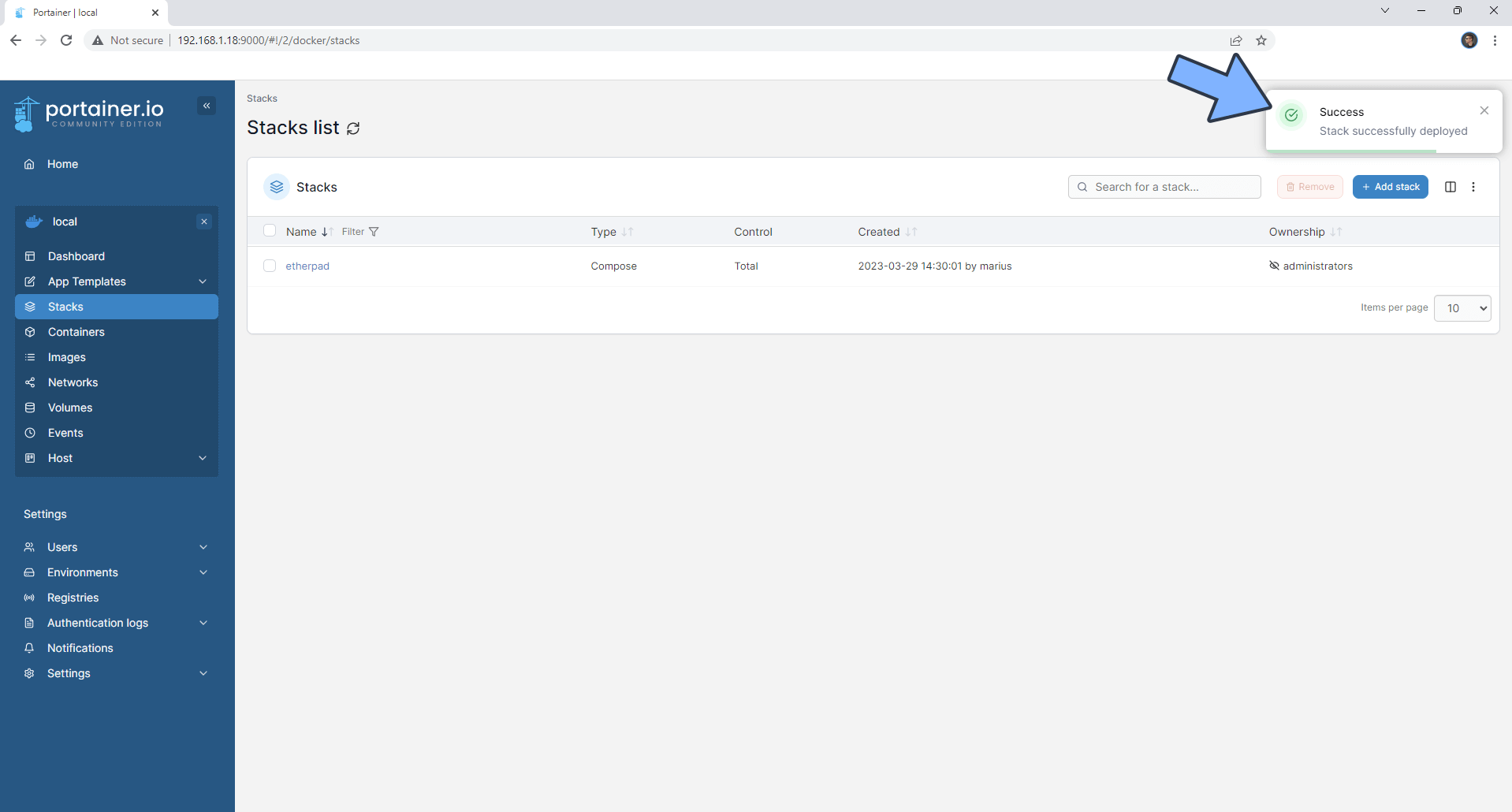
STEP 21
🟢Please Support My work by Making a Donation. Almost 99,9% of the people that install something using my guides forget to support my work, or just ignore STEP 1. I’ve been very honest about this aspect of my work since the beginning: I don’t run any ADS, I don’t require subscriptions, paid or otherwise, I don’t collect IPs, emails, and I don’t have any referral links from Amazon or other merchants. I also don’t have any POP-UPs or COOKIES. I have repeatedly been told over the years how much I have contributed to the community. It’s something I love doing and have been honest about my passion since the beginning. But I also Need The Community to Support me Back to be able to continue doing this work.
STEP 22
Now open your browser and type in your HTTPS/SSL certificate like this https://etherpad.yourname.synology.me that you have previously created at STEP 6. In my case it’s https://etherpad.mariushosting.synology.me If everything goes right, you will see the Etherpad Login page. In the Username field type in admin and in the Password field type in your own ADMIN_PASSWORD that you have previously created at STEP 18, then click Sign In. Follow the instructions in the image below.
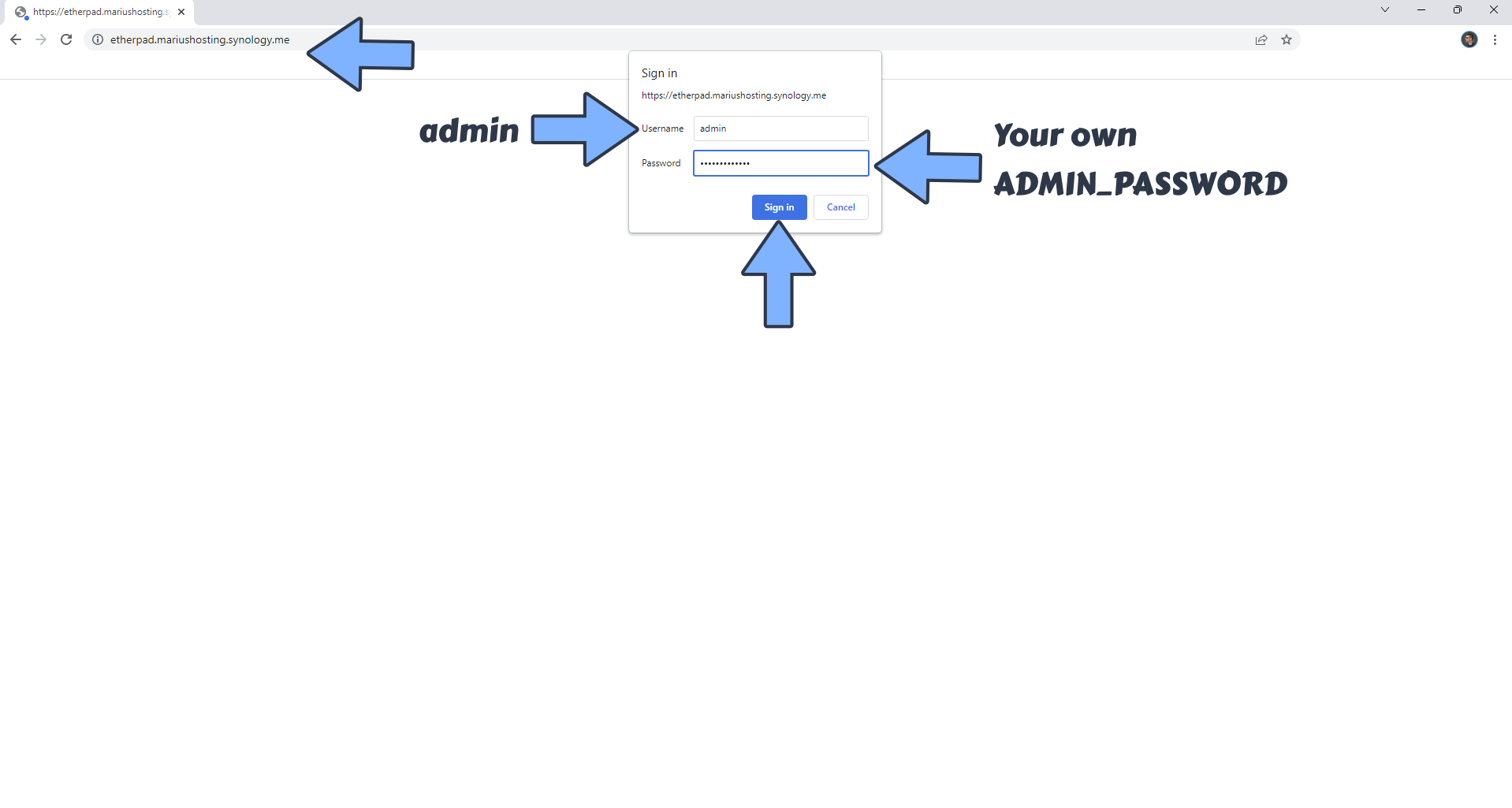
STEP 23
Give a name to the Pad then click OK. Follow the instructions in the image below.
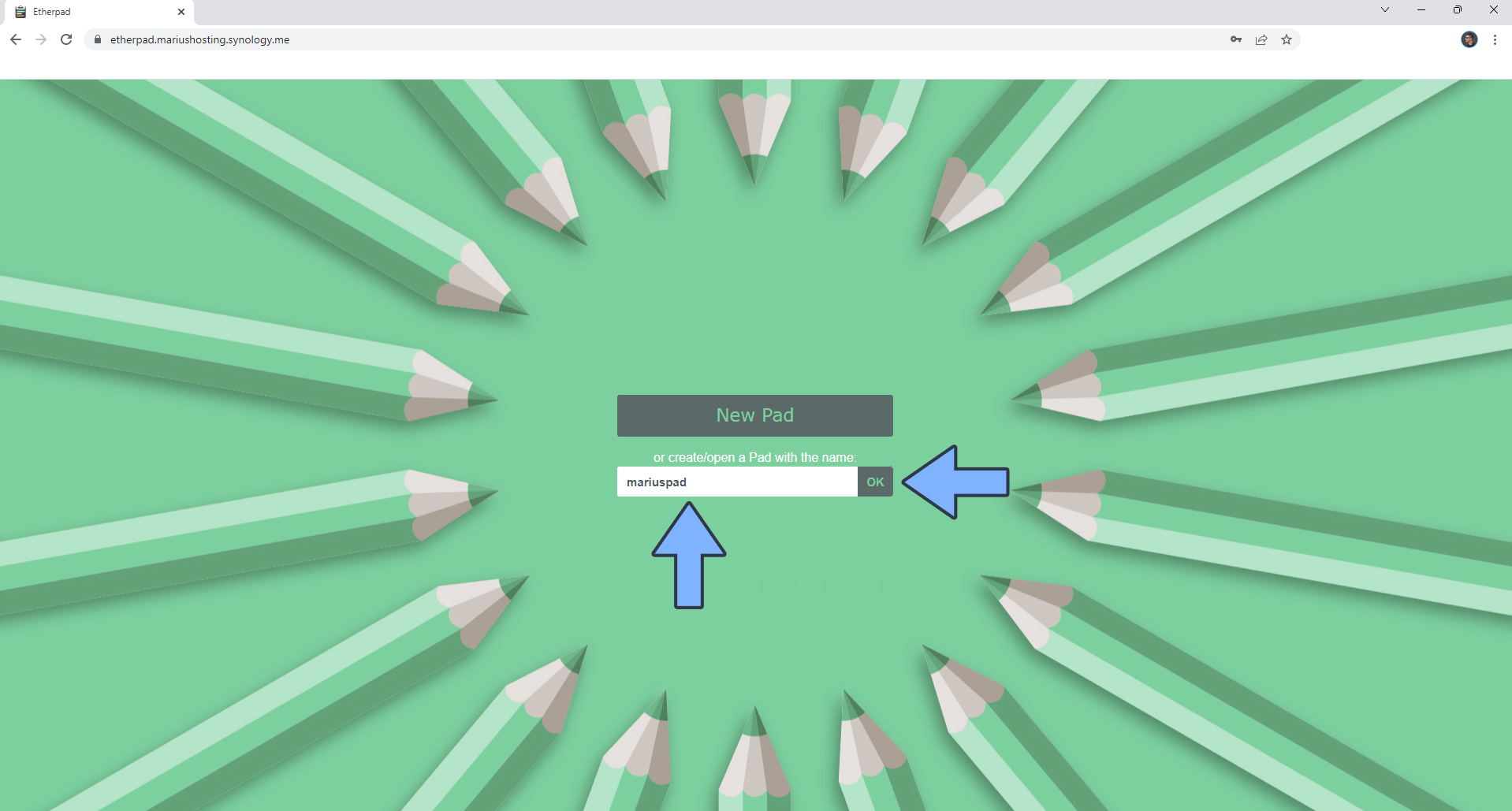
STEP 24
Share and invite friends to join your Pad.
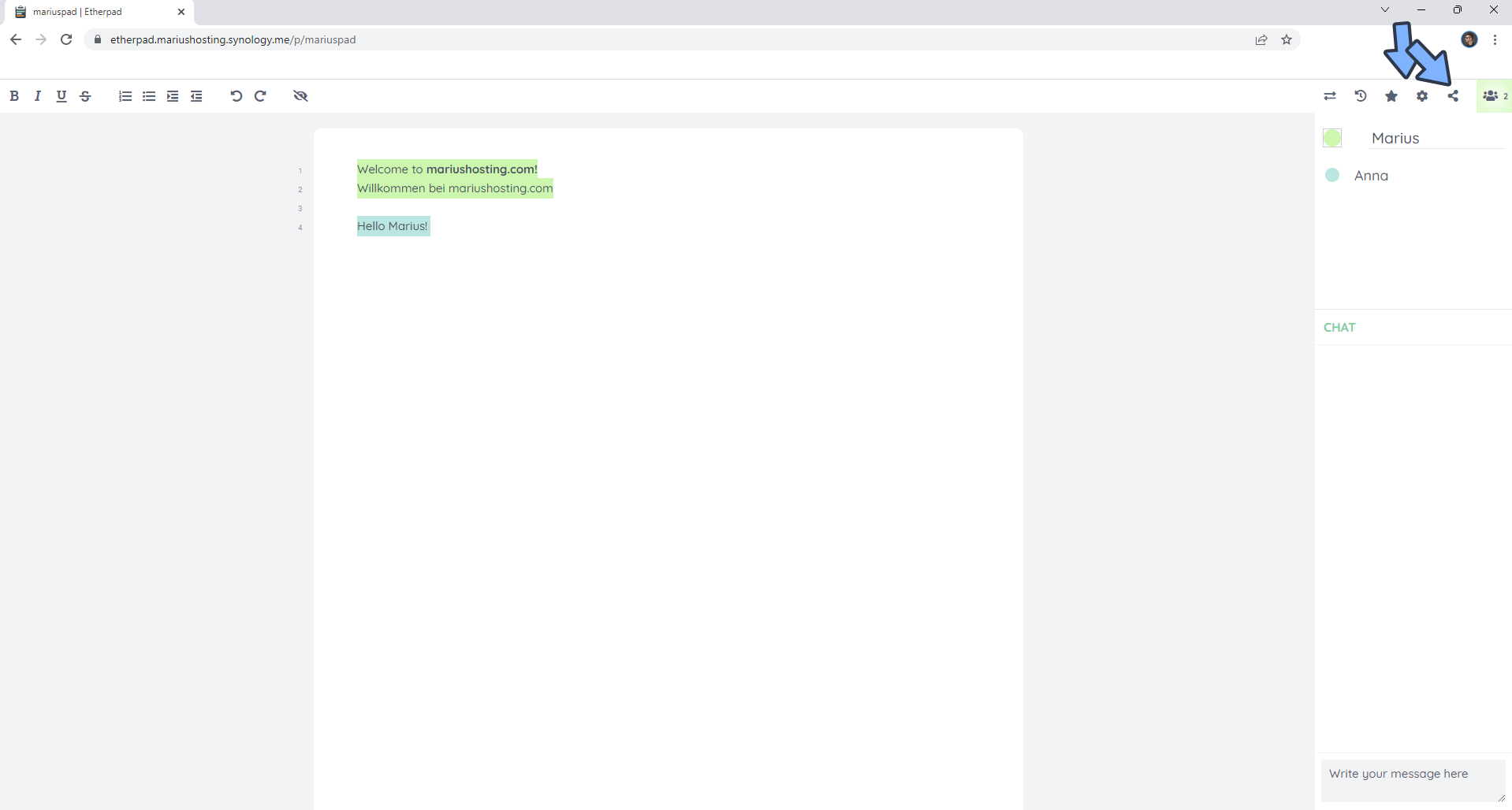
STEP 25
If you want to invite a friend to join your Pad, you have to give them your USER_PASSWORD that you have previously set up at STEP 18 (NOT your admin password!). In the Username field, they should type in user instead of admin and, in the Password field, they should type in the USER_PASSWORD that you have previously set up at STEP 18.
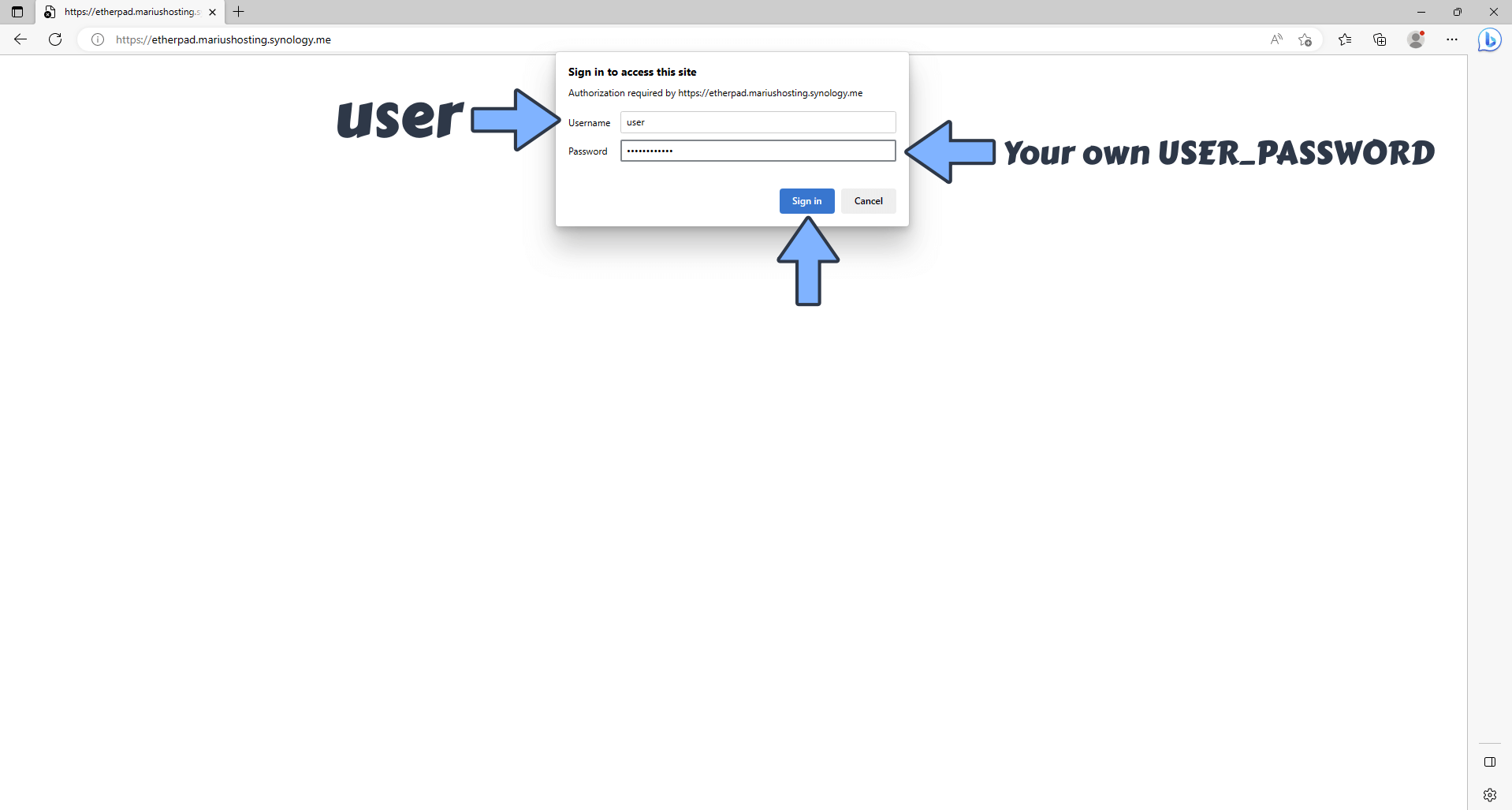
Enjoy Etherpad!
If you encounter issues by using this container, make sure to check out the Common Docker issues article.
Note: Can I run Docker on my Synology NAS? See the supported models.
Note: How to Back Up Docker Containers on your Synology NAS.
Note: Find out how to update the Etherpad container with the latest image.
Note: How to Free Disk Space on Your NAS if You Run Docker.
Note: How to Schedule Start & Stop For Docker Containers.
Note: How to Activate Email Notifications.
Note: How to Add Access Control Profile on Your NAS.
Note: How to Change Docker Containers Restart Policy.
Note: How to Use Docker Containers With VPN.
Note: Convert Docker Run Into Docker Compose.
Note: How to Clean Docker.
Note: How to Clean Docker Automatically.
Note: Best Practices When Using Docker and DDNS.
Note: Some Docker Containers Need WebSocket.
Note: Find out the Best NAS Models For Docker.
Note: Activate Gmail SMTP For Docker Containers.
This post was updated on Saturday / April 12th, 2025 at 12:05 AM
